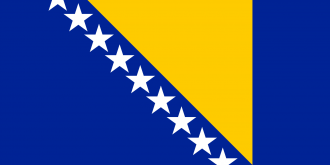Bosnia and Herzegovina (BiH) is located in the western Balkans, in one of the historically most troubled regions of Europe. Occupying a central position, in relation to the other republics of the former Yugoslavia, the country borders to the northwest with Croatia, to the east with Serbia and to the southeast with Montenegro. BiH is also wet by the Adriatic Sea along a narrow corridor leading to its short (20km) coastline, at the south part of the country.
The Bosnian conflict having taken place during the period 1992-1995, led the country to a significant economic deconstruction. After the signing of the Dayton agreement in 1995, new balances were brought in the area.
Today, the country’s population is estimated at about 3,810,000, consisting of numerous ethnic groups, with the largest one being Bosniaks –more than 50% of the overall population, followed by Serbs and Croats (See chart below). The segregation into these groups, is found to be due to religious affiliation, while the majority of the citizens speaks the Serbo-Croatian language.
Additionally, more than half of the people live in the rural central and northern areas, while, about 318,000 (2015) people, live in the country’s capital Sarajevo.
As for the political system, Bosnia and Herzegovina state, according to the Dayton agreement, consists of two highly autonomous entities, the Bosnian Serb Republic –known as Rebublika Srpska- and the federation of Croats and Bosnians – known as the Federation of Bosnia and Herzegovina.
On a constitutional level, each entity has its own legislature and parliament body. More specifically, Bosnia and Herzegovina, directly elects a tripartite presidency which rotates every eight months, between the Bosniaks, Serbians and Croatians. Moreover, the parliament consists of two parts; 2/3 of members are reserved for the Federation, while the rest is reserved for the Republic of Srpska members. Despite the inefficiencies of the current electoral system, nationalists adhere to their opposition for change.
On a local level, the Federation of Bosnia and Herzegovina –highly decentralised- has been administratively divided into ten cantons, which are further divided into many municipalities (općine). On the other side, the Republic of Srpska, more centralised, is divided into municipalities (opštine).
Today, social and economic disparities are evident; opportunities for women are significantly less in various areas, while some 37.3% of the overall population is considered multi-dimensionally poor.
It seems that social inclusion policies are not yet harmonised across the different entities within BiH, as high inequalities still persist; in 2013, BiH’s Gini coefficient indicator was 36.2, while inequalities in income and education levels are of the highest in the western Balkans. Considering the latter, it is indicative that despite the fact that the illiteracy level has fallen when compared to the previous century, the current educational system, is based on ethnic discrimination, at all levels, which in turn does not offer the opportunity for the assimilation of the three different ethnicities, into one.
Despite the above, Bosnia and Herzegovina’s HDI ranking–reflecting the human development in multiple dimensions- of 0.733, places the country at the 85th position worldwide for 2014 and with an annual growth rate of 0.78% (over the period 2010-2014) –much higher than the rest of western Balkans-, indicate that the country can eliminate disparities through initiatives at the communal, legal and governmental levels.

